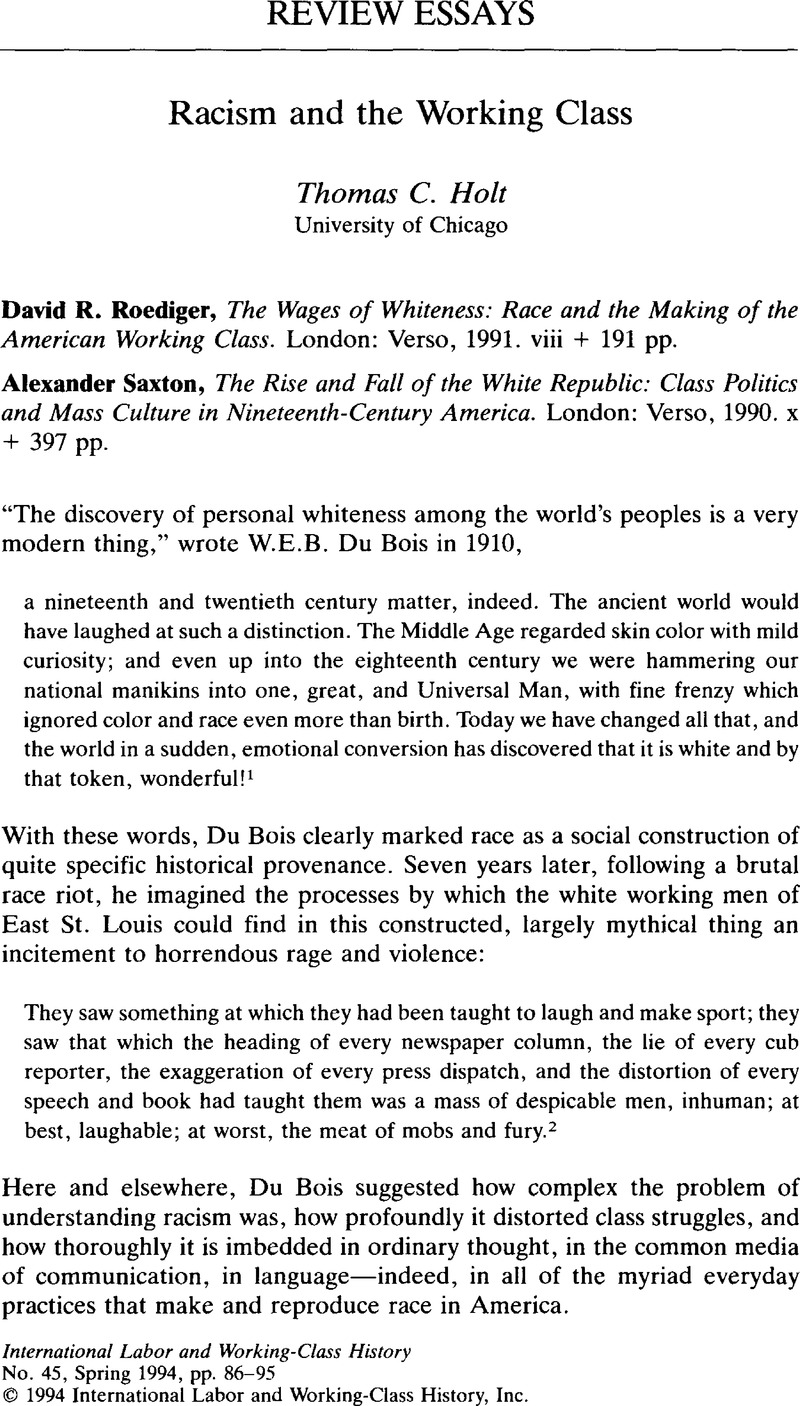Published online by Cambridge University Press: 16 December 2008

1. Bois, W.E.B. Du, “The Souls of White Folk,” in Darkwater: Voices from Within the Veil (New York, 1921), 30.Google Scholar
2. Bois, W.E.B. Du, with Gruening, Martha, “The Massacre of East St. Louis,” The Crisis 14 (09 1917):219–38, reprinted in Darkwater, 88.Google Scholar
3. See Fields, Barbara J., “Ideology and Race in American History,” in Region. Race. and Reconstruction: Essays in honor of C. Vann Woodward, ed. Kousser, J. Morgan and McPherson, James M. (New York, 1982), 143–77;Google Scholar and idem, “Slavery, Race and Ideology in the United States of America,” New Left Review 181 (1990):95–118. On the various forms of reductionism, see Hall, Stuart, “Race, Articulation and Societies Structured in Dominance,” in Sociological Theories of Race and Colonialism (Paris, 1980), 305–45.Google Scholar
4. On the general problematic see de Certeau, Michel, The Practices of Everyday Life, trans. Randall, Steven F. (Berkeley, 1984);Google ScholarLefebvre, Henri, Critique de la Vie Quotidienne (Paris, 1958);Google ScholarLüdtke, Alf, “The Historiography of Everyday Life: The Personal and the Political,” in Culture, Ideology and Politics, ed. Samuel, Ralphel and Jones, Gareth Stedman (Routledge, 1982), 38–54;Google Scholar and Peukert, Detlev J.K., Inside Nazi Germany: Conformity, Opposition and Racism in Everyday Life (New Haven, 1987).Google Scholar On ideology, culture, and race see Gilroy, Paul, “There Ain't No Black in the Union Jack”: The Cultural Politics of Race and Nation (Chicago, 1991);Google Scholar and Hall, Stuart et al. , eds., Culture, Media, Language: Working Papers in Cultural Studies, 1972–79 (Birmingham, 1980).Google Scholar
5. See Drescher, Seymour, Capitalism and Antislavery: British Mobilization in Comparative Perspective (New York, 1987).Google Scholar
6. For the phenomenon in Europe, see Delbourg-Delphis, Marylène, Masculin singulier: le dandysme et son histoire (Paris, 1985);Google ScholarFavardin, Patrick and Bouëxière, Laurent, Le dandysme (Paris, 1988);Google Scholar and Auslander, Leora, Style, Taste, and Power: Furnishing Modern France (Berkeley, forthcoming).Google Scholar For theoretical considerations relevant to such phenomena in America, see Sedgwick, Eva Kosofsky, Epistemology of the Closet (Berkeley, 1990).Google Scholar
7. For literature see classic, Leslie Fiedler's, Love and Death in the American Novel (New York, 1966);Google Scholar on transvestism, Garber, Marjorie, Vested Interests: Cross-dressing and Cultural Anxiety (London, 1992);Google Scholar on bourgeois anxiety, see Halttunen, Karen, Confidence Men and Painted Women: A Study of Middle Class Culture in America, 1830–1870 (New Haven, 1982).Google Scholar
8. See Toll, Robert, Blacking Up: The Minstrel Show in Nineteenth-Century America (New York, 1974).Google Scholar